Painting of House Cat Dreaming Its a Tiger Art
Today is the day - for some it's more important than Valentine's Day, more than important than Boxing Day, and fifty-fifty more than important than International Pizza Day. Today is... INTERNATIONAL Cat Twenty-four hour period! To mark this very special occasion nosotros have cats in art for everybody!
As the proud owner of Pimpa the Cat, the laziest cat in the world, I do what I must do to celebrate this occasion. I have collected fifteen of the most purrific cats in art history that every cat lover would want to put on their wall. In some of these pieces the cats play the main role while in others they are just there, even though we all know that in reality cats e'er play the main role considering they dominion the world.
Bask!
1. Louis Wain - The Bachelor'south Political party
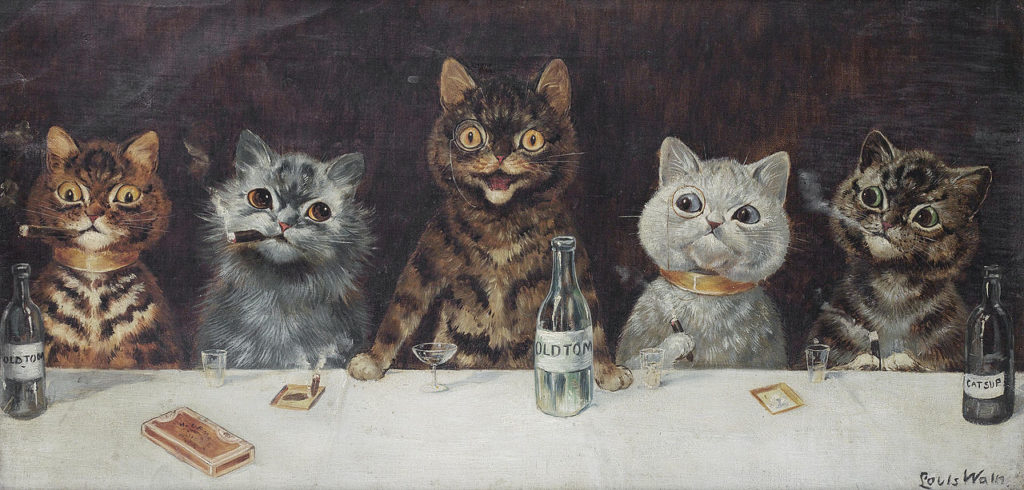
Louis Wain and his cats deserve an article all their ain - one mean solar day it will be published here, I promise! Wain was i of the near pop English language illustrators. Born in 1860, he became famous for his anthropomorphic portrayals of cats. As the English writer H.G. Wells remarked, "he invented a cat style, a cat society, a whole cat earth." The thing is that Wain was mentally ill and probably had schizophrenia which might accept caused his obsession with cats (read more: iv Artists Who Suffered Mental Disease And How It Affected Their Art). He became known as a leading potency on all things cats and was elected president of the National Cat Gild. Likewise he judged cat competitions and was involved in several beast charities. He worked for about thirty years, sometimes producing as many every bit several hundred drawings a year - which amuse cat and fine art lovers to this 24-hour interval.
two. Franz Marc - The White Cat
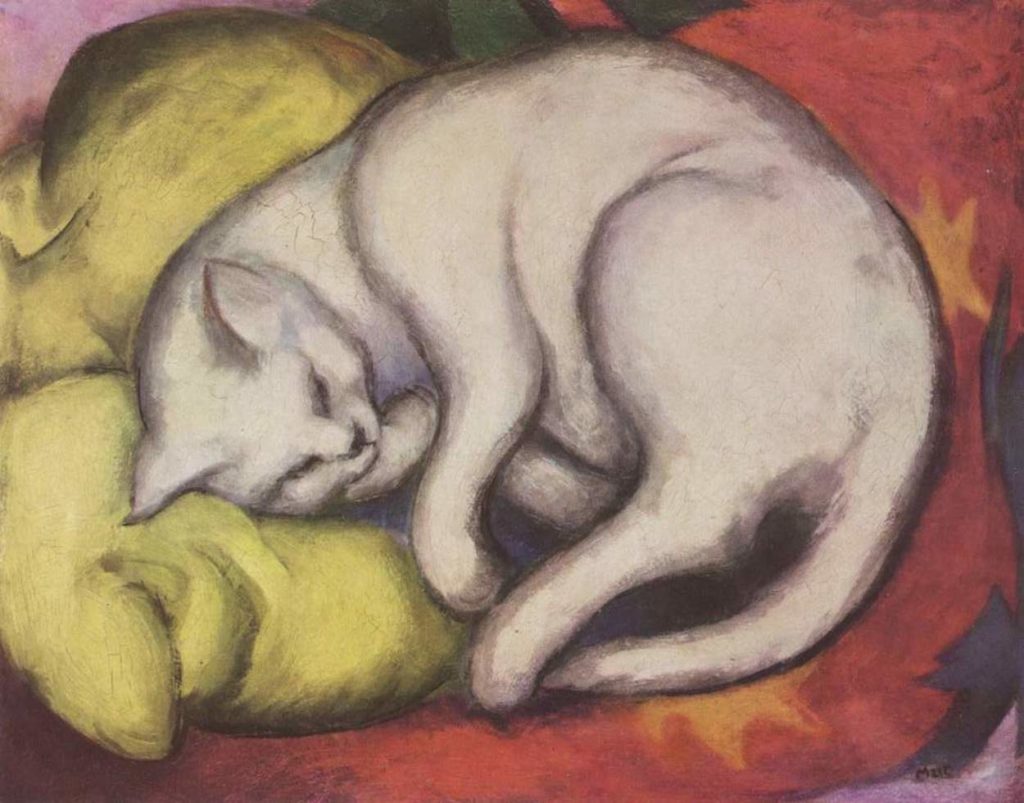
Franz Marc is known for his images of brilliantly colored animals - horses, dogs, and of class, cats. In 1911-12 Marc displayed his works in Munich. His paintings of cats illustrate the animals in their natural state of sleeping or preparation. Some of his famous cat paintings show cats on a xanthous pillow, two cats bluish and yellow, cats in a basket, and cats on a crimson textile. For him, animals were the ideal symbol of purity, truth, and beauty. Likewise he believed in the symbolism of colors - bluish meant spirituality and masculinity, yellow feminine happiness, and ruby represented violence.
three. Hiroshige II - A White Cat Playing with a String
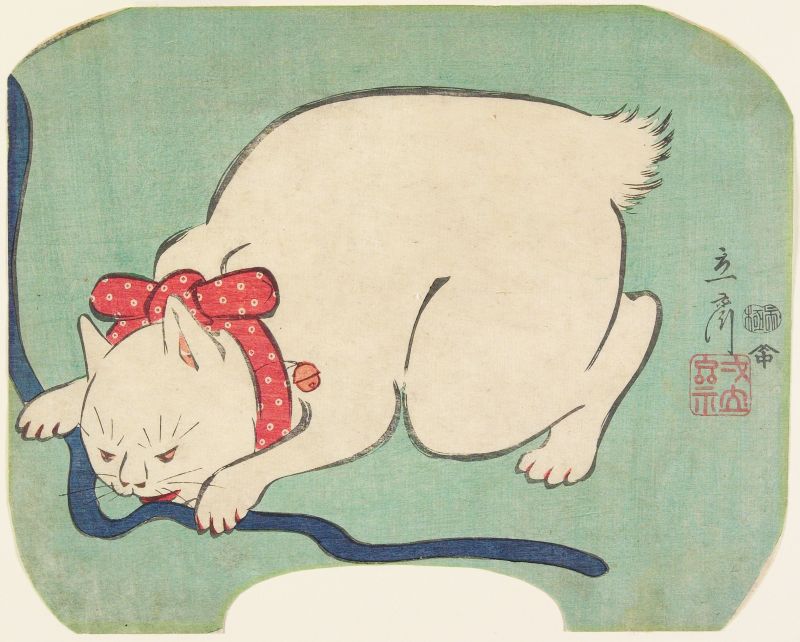
This is a rather unusual fan print designed by Hiroshige Two who oft closely followed the style and designs of his immensely successful mentor (who was, of grade, also chosen Hiroshige). This print reflects Hiroshige Ii's own unique approach. Information technology shows the artist's close ascertainment of a firm cat, depicted in a bold and minimal manner. This beautiful and chubby, white bobtail cat is biting a blue cord. With hind legs braced against the ground, he appears ready to pounce. If y'all are a cat possessor you know this cat'southward face up very well!
4. Suzan Valadon - Raminou
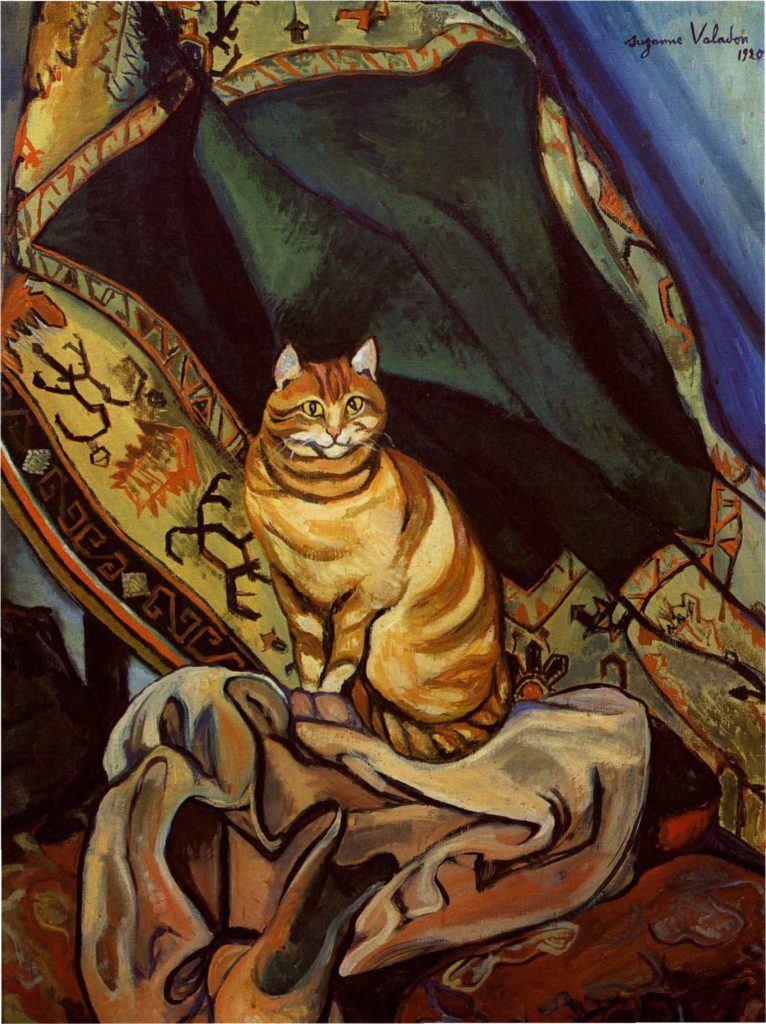
Suzanne Valadon was a French painter and artists' model. In 1894 she became the commencement woman painter admitted to the Société Nationale des Beaux-Arts. Valadon painted yet lifes, portraits, flowers, and landscapes that are noted for their strong limerick and vibrant colors. She was, however, best known for her candid female nudes that depict women's bodies from a woman's perspective. She was also a cat lover and often painted her cats, specially her favorite, the fat Raminou.
v. Marc Chagall - La Poeté
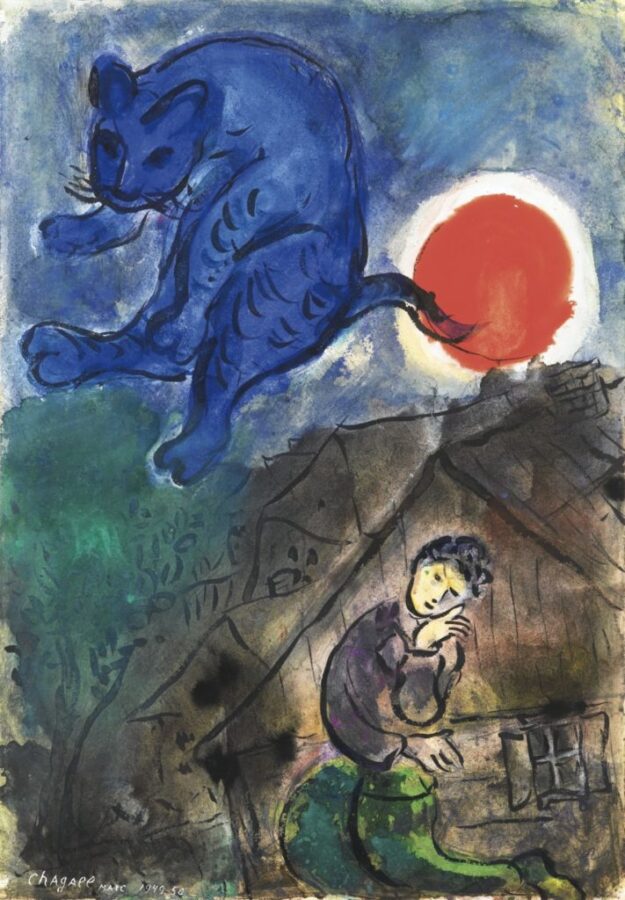
Known equally a pioneer of modernism and a major Jewish artist, Marc Chagall experienced modernism'south "golden historic period" in Paris, where he synthesized the art forms of Cubism, Symbolism, Fauvism and Surrealism. Through his long life he used typical motifs and subjects in virtually of his work: village scenes, peasant life, and intimate views of the small-scale world of the Jewish village, all presented in a dreamy, unreal manner. Cats often helped emphasize the fantastic character of his paintings and played a major role in many of them. They are usually the companions of the figures he painted - poets, musicians, or women like nosotros encounter in the painting to a higher place.
half-dozen. Pablo Picasso - True cat Catching A Bird
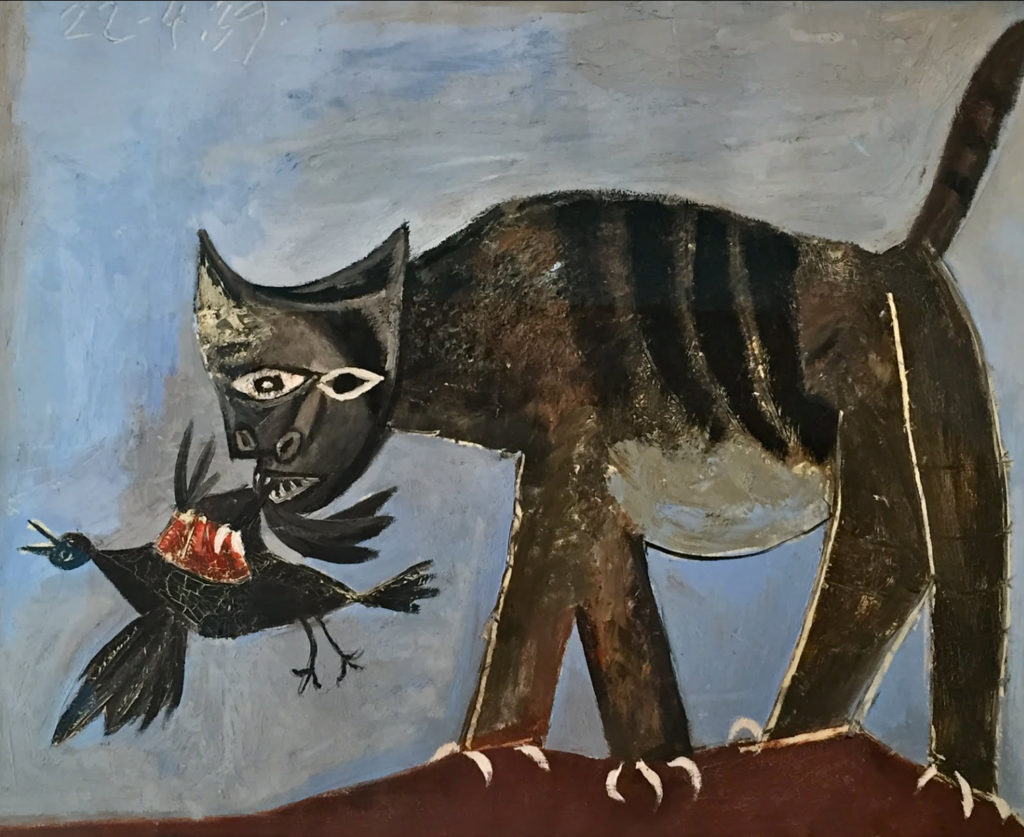
Picasso'due south Cat Catching a Bird was created in a couple of versions in 1939 - the year of the outbreak of the war. As Picasso himself recalled, "The subject obsessed me, I don't know why". The bird struggles desperately to free itself from its tormentor'south concord. The neutrality of the background does nothing to salve the horror of the scene. Information technology is an prototype of everyday life blown upwardly to apocalyptic proportions. The true cat is postponing the killing of the bird for equally long every bit possible - the longer he does information technology, the longer he is in absolute power.
7. Min-Zhen - The Black True cat
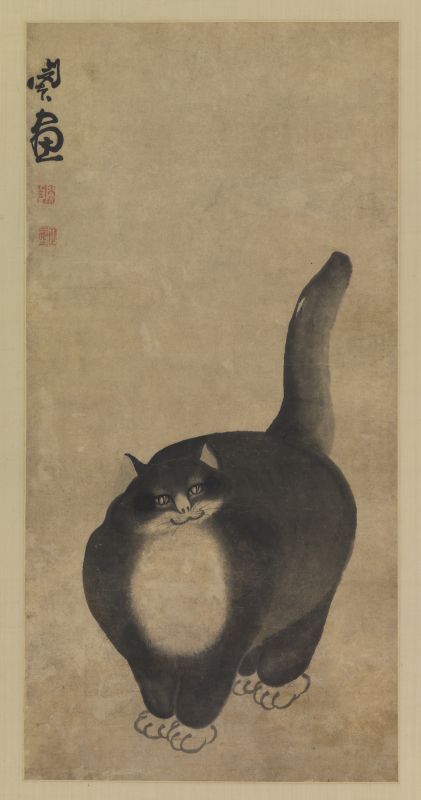
Picasso's cat was a barbarous one - fourth dimension for a smiling one! Min Zhen was a Chinese painter and seal carver born in Nanchang, Jiangxi, who spent virtually of his life in the Chinese metropolis of Hubei. He was noted for painting human figures and occasionally doing finger painting. He was orphaned at an early age and is sometimes associated with the Eight Eccentrics of Yangzhou, which is the proper name for a grouping of eight Chinese painters active in the 18th century who were known in the Qing Dynasty for rejecting orthodox ideas about painting in favor of a mode they deemed expressive and individualist.
It was hard to discover any data about this gorgeous fat cat, but perhaps no more comments are needed here. He has only eaten all the cat food in the earth and is happy now.
eight. Henriette Ronner-Knip - The Cat at Play
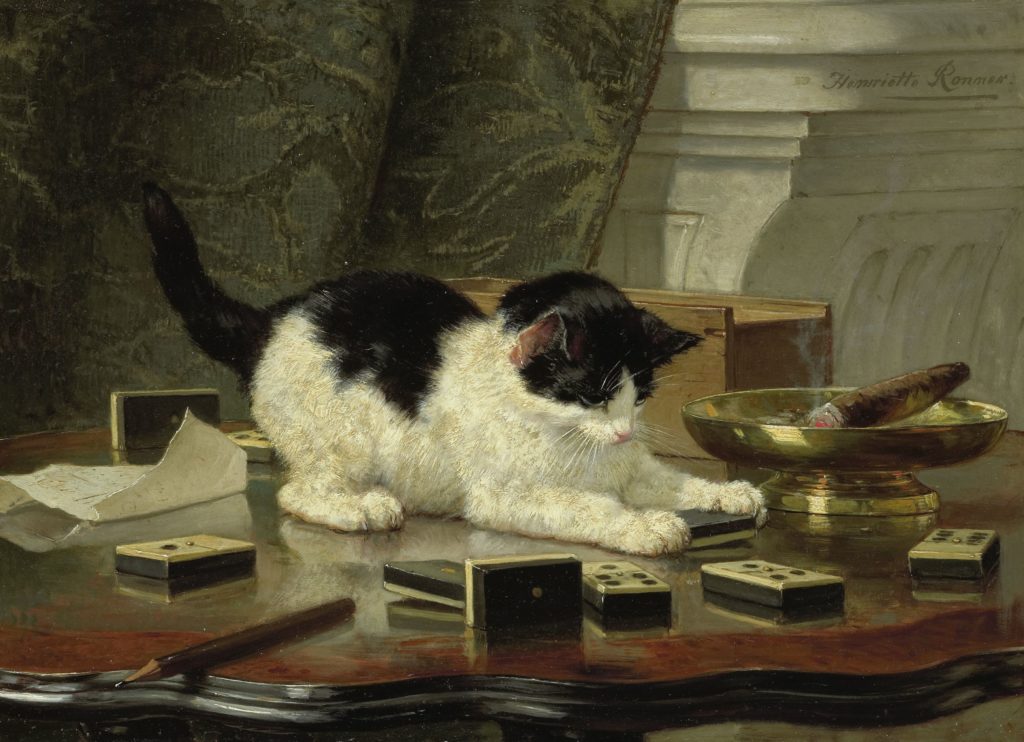
Henriëtte Ronner – Knip was built-in in Amsterdam into a family unit of painters. She is well known for her paintings of domestic pets, primarily cats. Paintings of pets were popular with the wealthy conservative in the Victorian era and her many paintings of cats getting into mischief in domestic scenes proved to be favorites. Generally sentimental portrayals, her paintings rarely offer whatever metaphorical meanings and are focused merely on the cats themselves. She studied her true cat subjects avidly and with sincerity. She fifty-fifty went so far as to construct a specially built glass-fronted studio in which her cats could freely scamper about, sleep, and get into the types of trouble that simply cats tin become themselves into.
9. Bart van der Leck -The Cat

Bart van der Leck is primarily known as the cofounder of the magazine De Stijl. In 1916, like Piet Mondrian, he opted for radical brainchild in his work and to utilise the primary colors of cerise, yellow, and blue. That choice was preceded by a quest for a new visual idiom. The classical Egyptian fine art in the Louvre impressed him during a visit to Paris. Inspired by this, he developed a style with highly simplified forms and sober colors. Consequently in The Cat, Van der Leck depicted the animal both from the side and in profile, and used simply blackness, white, red, and orange.
10. Pierre-Auguste Renoir -Julie Manet besides known as Child with Cat
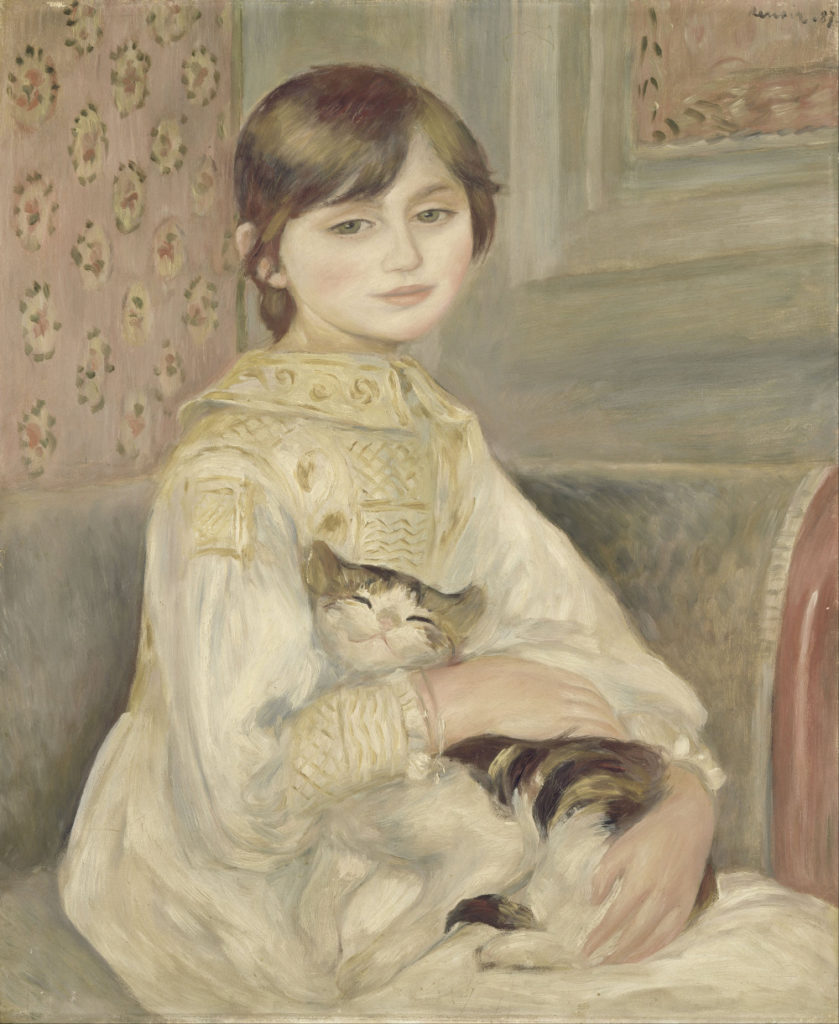
Berthe Morisot and her husband Eugène Manet, brother of the painter, had known Renoir for many years. The Manets' adoration for the painter's talent convinced them, in 1887, to commission a portrait of their daughter Julie. The cat is here only the addition, but such a sweet i! Not to mention that it looks much happier than Julie. Perhaps she didn't like Renoir's paintings, just like some American art aficionados over one hundred years afterwards.
11. Marguerite Gérard - The Cat's Lunch
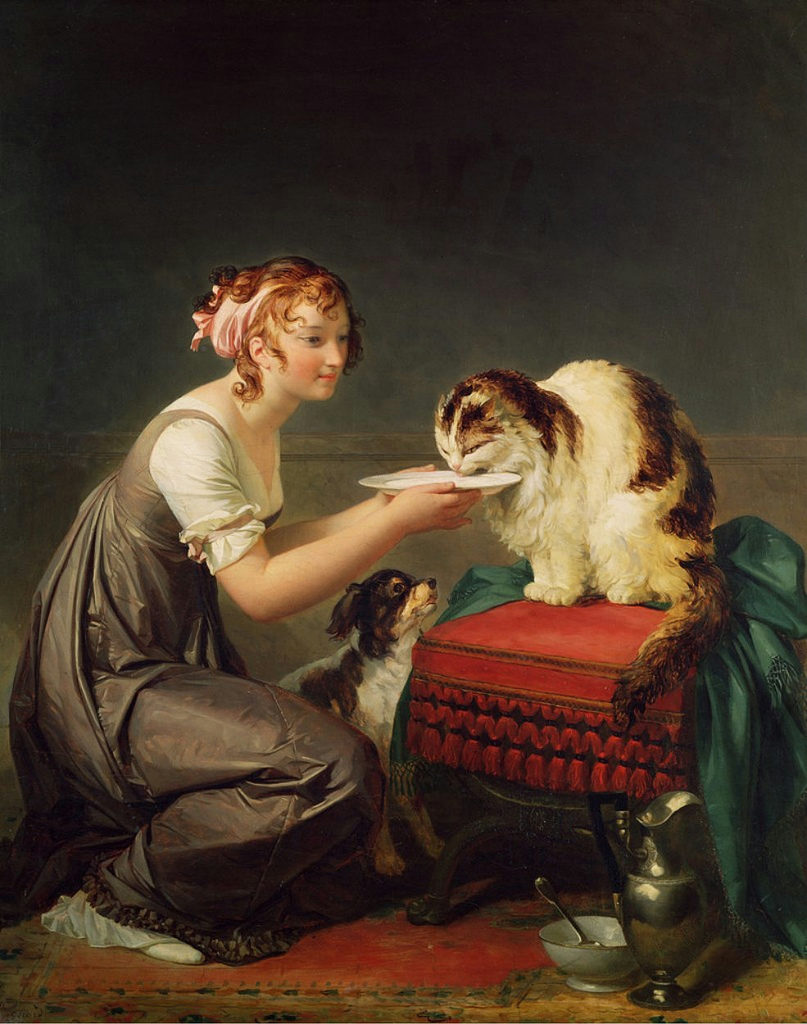
This is how my cat looks when I give him nutrient.
Marguerite Gérard was famous for producing oil paintings and etchings under her blood brother-in-law, the great Jean-Honoré Fragonard. Peradventure he convinced her to add cats to her compositions as he was as well famous for doing that. As a genre artist, Gérard focused on portraying scenes of intimate domestic life. However, unlike other female person painters who liked to refer to classical antiquity, Marguerite Gérard often used costumes and settings from a few centuries earlier. Many of her paintings illustrate the experiences of motherhood and childhood within the household, and several emphasize the importance of music and female companionship. Cat companionship is equally important, as we can see in this painting.
12. Pierre Bonnard - The White Cat
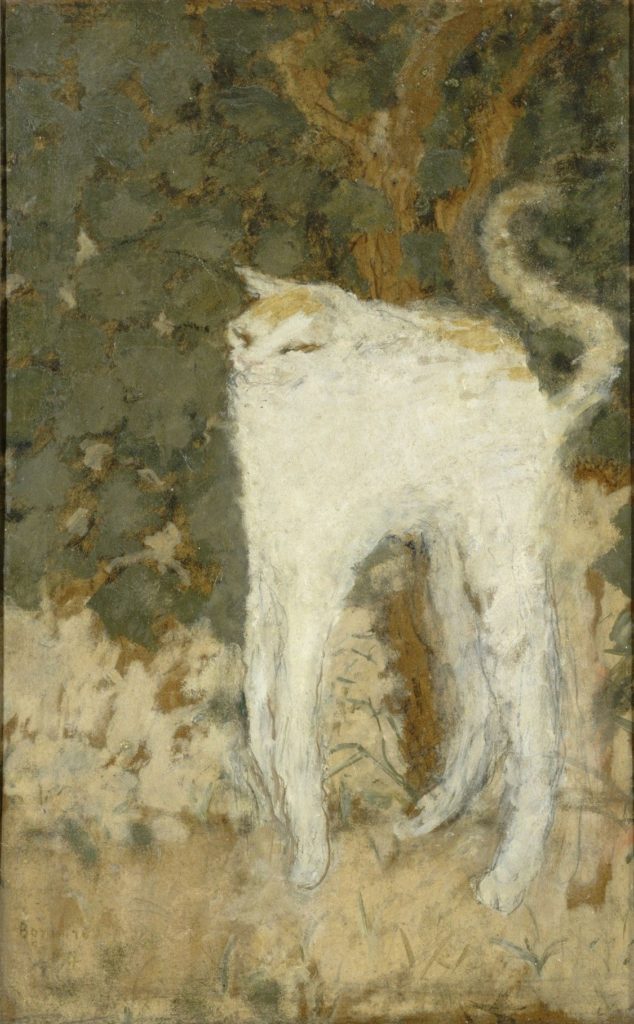
Here, Bonnard used distortion to create a humorous image of this cat arching its dorsum. The painter spent a long time deciding on the shape and the position of the paws, equally tin exist seen in the preparatory drawings. Japanese inspiration can exist found in the bold, asymmetric limerick as well as in the option of subject area – one that was very popular in the prints that Bonnard was so addicted of. Both Hokusai and Kuniyoshi in item, whose work you can besides spot in this commodity, had painted cats. Throughout his piece of work, Bonnard produced innumerable paintings that featured cats, sometimes as a simple detail, visible to a greater or lesser degree, sometimes, like The White True cat, as the key subject.
thirteen. Utagawa Kuniyoshi -Cats Suggested as the L-three Stations of the Tōkaidō
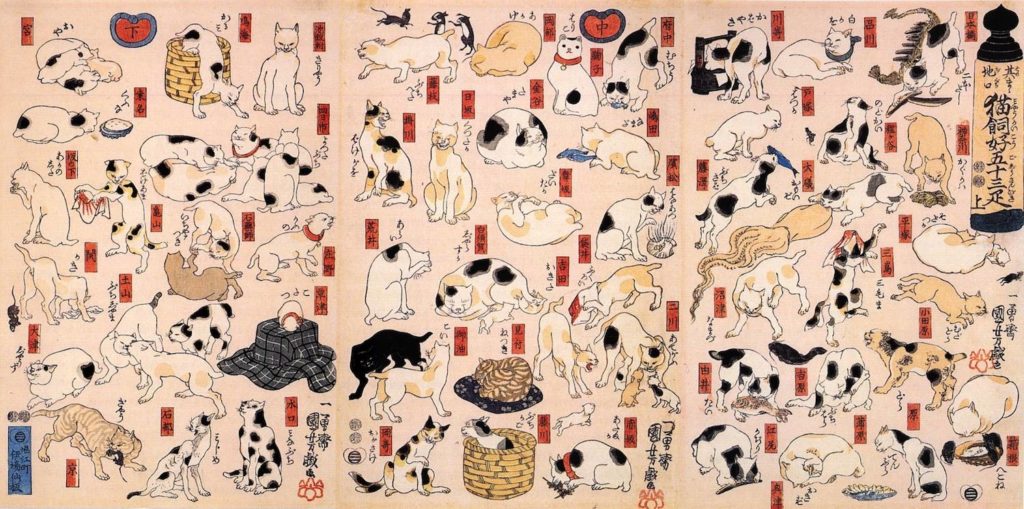
Fifty-5 cats announced in this triptych impress by the Japanese illustrator Utagawa Kuniyoshi. One of them crawls out of a basket, a few catch rats, others eat fish. Kuniyoshi loved cats. When he became a teacher, his students noted that his studio was overrun by them. His fondness for felines crept into his piece of work and they appear in many of his finest prints. Sometimes they appear every bit characters from well-known stories, other times they are beautifully expressive studies. Often Kuniyoshi would depict cats in a fully anthropomorphic grade, similar the afterward Louis Wain.
Cats Suggested as the Fifty-iii Stations of the Tōkaidō is a fun spoof on Hiroshige's The L-three Stations of the Tōkaidō which was the bestselling collection in the history of ukiyo-e. The Tōkaidō – or 'Eastern Sea Road' – had fifty-3 different post stations along its route and these provided stables, food, and lodgings for travelers. Kuniyoshi decided to evidence these stations through true cat puns. For example, the forty-get-go station of the Tōkaidō is chosen Miya. This name sounds somewhat similar the Japanese discussion oya (親) which means 'parent'. For this reason, the station is depicted as two kittens with their mother.
14. Théophile Steinlen - The Conversation Noir
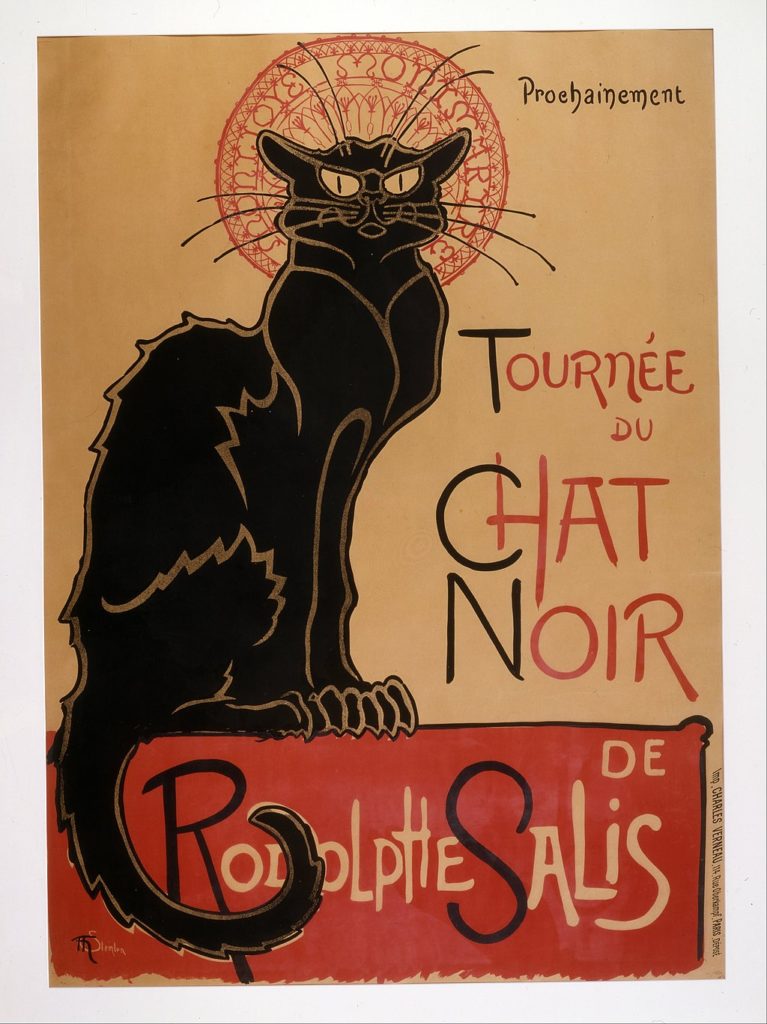
Le Chat Noir was a nineteenth-century amusement establishment in the bohemian Montmartre commune of Paris. It opened on xviii November 1881 at 84 Boulevard de Rochechouart by the impresario Rodolphe Salis and airtight in 1897 non long after Salis' death. It is believed to be the first modern cabaret: a nightclub where the patrons sat at tables and drank alcoholic beverages while beingness entertained by a diverseness bear witness on phase.
This iconic Théophile Steinlen affiche advertises a nightclub which in its heyday was part artist salon, and role rowdy music hall. From 1882 to 1895, the cabaret published a weekly mag of the same name featuring literary writings, news from the cabaret and Montmartre, poesy, and political satire. Today reproductions of this true cat can be bought everywhere in Paris.
xv. Jeff Koons - Cat on a Clothesline
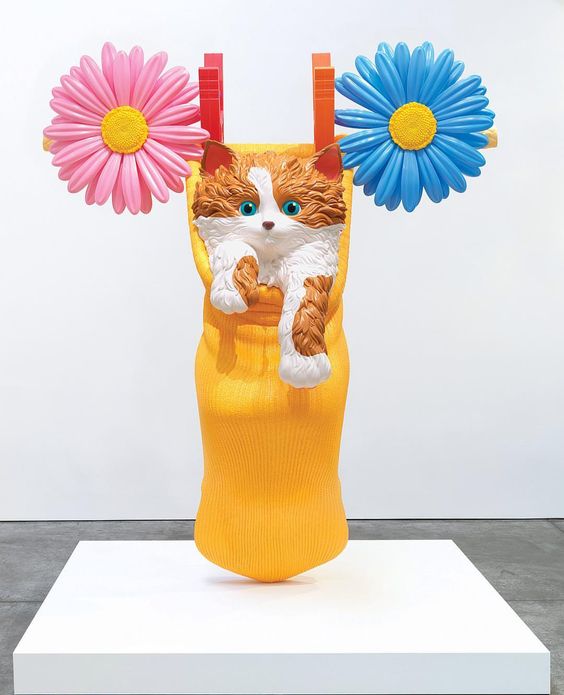
Whether or not you like Jeff Koons you tin't pass in front of his art indifferently. You wouldn't see it in this photo but his Cat on a Clothesline is gigantic, it measures 312.iv x 279.4 x 127 cm. For Koons, this piece of fine art is "like a contemporary crucifixion. Just it's also this cute little cat, that'south merely in a sock. You tin can besides think of information technology as a womb-similar state of affairs, feeling that sense of protection". You demand to determine for yourself what it is to you.
xvi* Pimpa
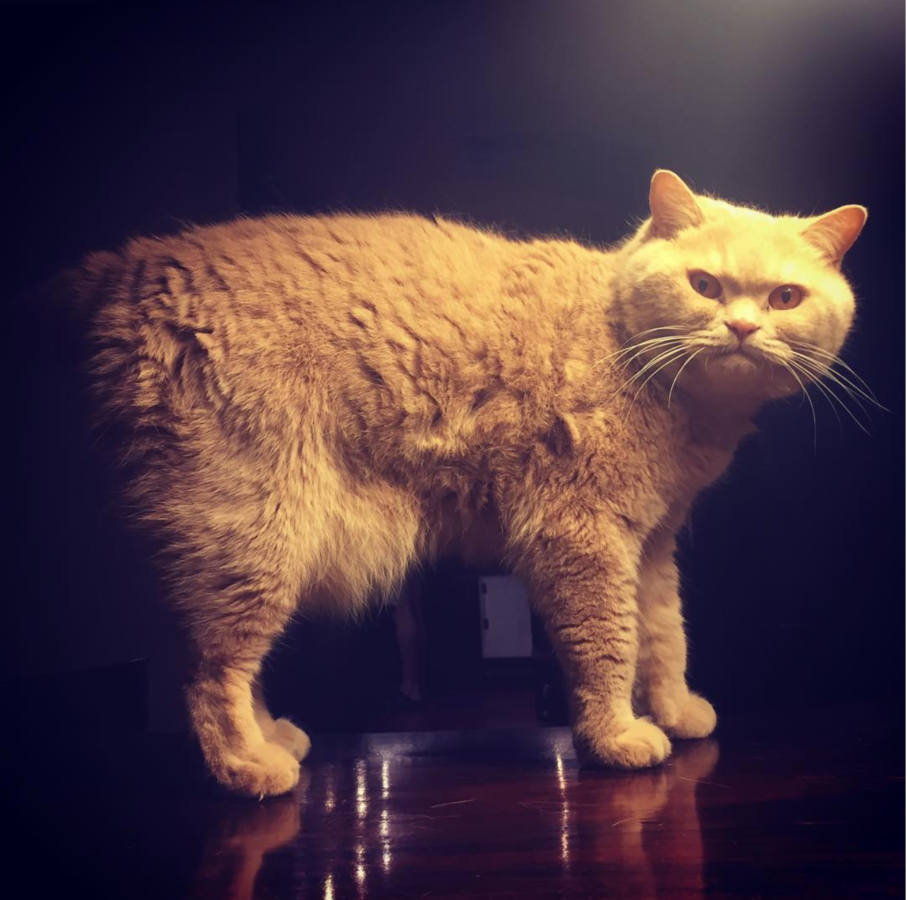
The last but non least... hither is Pimpa, the cracking supporter of DailyArt. I wish one of the peachy Dutch Masters of the Gilded Age could have washed his portrait! Or at least Hieronymus Bosch, he would do information technology OK as well, for example in his Concluding Sentence triptych which we recently featured in DailyArt app (iOS/Android). Anyways, after all these fantastic examples of cats in art history, I just had to show to you my true cat.
If yous oasis't had enough cats and their artists, Sorry artists and their cats, don't miss our article with photos of them: Run across Famous Artists And Their Cats (Cuteness Overload) :)
Happy International True cat Day!
Can't get enough of cats? We're non kittening around, swoop in:
Source: https://www.dailyartmagazine.com/15-cats-in-art/
0 Response to "Painting of House Cat Dreaming Its a Tiger Art"
Post a Comment